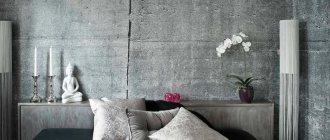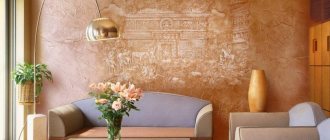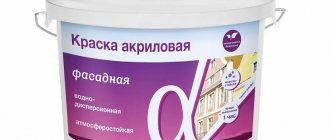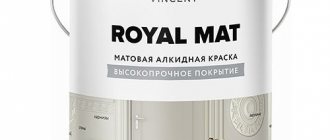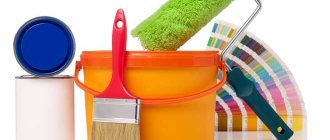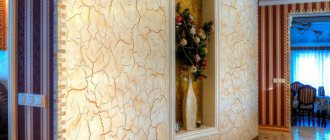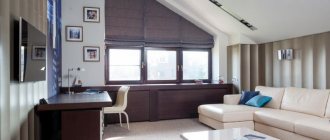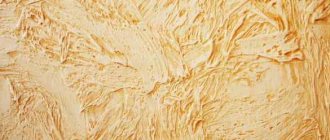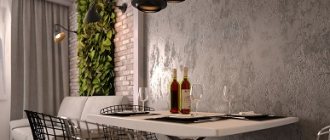Facade decorative plaster: pros and cons
Decorative plaster of facades is the most profitable option for high-quality cladding of a house from an economic point of view. Like any other method, it has its advantages and disadvantages, which we will try to consider in more detail.
Facade decorative plaster Source benimmulku.com
Options for combining different types of plaster Source womanadvice.ru
The advantages of decorative plaster include the following:
- High environmental properties.
- A huge variety of colors, textures, application methods.
- A simple application technique that even a person with no experience can handle.
- Aesthetic, high-quality result of the work performed.
- Durability, maximum immunity to external aggressors (rain, wind, ultraviolet radiation, sudden temperature changes).
- Unpretentiousness in further use.
Among the disadvantages of cladding, the following factors should be mentioned:
- Shorter service life compared to cladding with brick, clinker, and ventilated facades.
- Large time and energy costs required to finish the entire house. Because of this, in most cases it is necessary to use the services of hired teams.
- The need to carefully select the type of plaster depending on the material of the wall being treated.
- There is a chance of running into hackers who will perform work in violation of technological requirements. This can lead to not only a reduction in the service life of the facade, but also partial destruction of the main wall. For example, when using the wrong material for cladding a façade made of breathable aerated concrete.
Variety of textures of plasters for facades
Texture is an aesthetic point that has absolutely no effect on the service life and quality of the product. Each type of texture has a unique manufacturing method, since the process of its production uses raw materials that have a certain granularity of filling. A more abstract gradation of textures is divided into classical and modern, but in reality there are many more types, which we will talk about in more detail below. Classic compositions are the most proven, and they still do not lose their relevance. Modern models are distinguished by a recycled composition, which, as a rule, is of higher quality, but has a higher price.
Facade plaster - types of texture
Facade plaster, types of textures - this is the same multifaceted area in matters of analysis of this type of material for the design of external wall surfaces. There are several main types:
- Bark beetle
- Mosaic
- Barashkovaya
- Kameshkovaya
Facade decorative plaster: varieties and properties
The difference between decorative plaster for facades lies in the different components from which it is made. There are several types:
- Acrylic.
- Mineral.
- Silicone.
- Silicate.
The characteristics of popular types of decorative plaster for house facades are given in the table:
| Characteristics | Mineral based | Acrylic based | Silicate based | Silicone based |
| Main component | Portland cement | Acrylic resins | Liquid glass | Silicone resins |
| Vapor permeability coefficient | High | Short | High | High |
| Water absorption coefficient | High | Average | Average | Short |
| Possibility of contamination | Average | High | Low | Very low |
| Type of pigments | Inorganic | Inorganic, organic | Inorganic | Inorganic, organic |
| Elasticity index | Short | High | Average | High |
| Possibility of sunburn | High | Low | High | High |
| Risk of mold and mildew formation | Average | High | Low | Low |
| Resistance to mechanical damage | Low | High | High | High |
Important! Mineral-based decorative plaster is sold in the form of a dry mixture, packaged in paper bags. Before use, it must be diluted with water and mixed thoroughly. Recommended proportions are indicated on each package. Other types of compositions are sold ready-made, in plastic, hermetically sealed buckets.
Types of decorative plaster for finishing facades Source bazafasada.ru
“Wet facade” technology Source pro100stroy.com
Aesthetics of decorative plaster Source fasad-master.com
Classification of plasters, carried out according to the presence of decorative components, divides the material (regardless of the type of the main component) into 2 groups:
- Textured. It represents a uniform dough-like mixture, which can be tinted in any color at the mixing stage or painted already on the surface of the facade. This type is characterized by high plasticity, which allows you to create exquisite artistic masterpieces on the walls. This effect occurs due to the natural fibers included in the mixture. Cotton and linen wood are most often used; some manufacturers add ground brick. Using textured decorative plaster, you can make original panels, bas-reliefs, and three-dimensional paintings.
Healthy! Some of the brightest representatives of the group are such types of plaster as “Venetian”, “American” and “Popcorn”.
- Structural. It is a heterogeneous granular mass. The main component is the binder. There can be two types: solvent-based or water-based. This affects what will be used to dilute the mixture until the thickness required for work is obtained: water or solvent.
Healthy! The category of structural decorative plaster includes the most famous types: “Lamb”, “Bark Beetle”, “Fur Fur”.
Wet plaster technology
Wet plaster technology is used to create a comfortable indoor microclimate. The process of applying wet plaster: the walls are primed, insulated with mineral wool or polystyrene foam, then the material is secured with reinforcing mesh, and after that facade plaster can be applied. Sometimes, to increase the bonding properties, another layer of primer is required before plastering.
Advantages of wet plaster:
- plastering without joints;
- the ability to cover cavities and uneven walls;
- reduction of heat loss;
- high adhesion to different materials (brick, concrete, wood, etc.).
In order for the wet facade to remain durable and strong, it is important to correctly apply the reinforcing layer. Its thickness should be less than six millimeters. The reinforcement consists of 3 layers: adhesive, fiberglass reinforcing mesh, and adhesive again.
Decorative plaster based on acrylic
Acrylic facade decorative plaster is made by mixing polymer-mineral compositions. It is characterized by high elasticity, sold in plastic buckets of different capacities, in the form of a ready-made mixture. When stagnant, it settles, squeezing out the aqueous dispersion from its structure. Therefore, the composition must be thoroughly mixed before use. Similar actions are carried out when adding color.
The composition of acrylic plaster can be divided into 4 components, one of which is a water dispersion. Others include:
- Modifiers are designed to enhance qualities that were previously conceived.
- Dyes - are used to give the composition a given color. Although it is much easier to use the principle of tinting.
- Fillers – contribute to obtaining a textured surface and decorative relief.
Acrylic decorative plaster is classified according to several criteria. First of all, these are the conditions of use: in this case, both façade and universal can be used.
The main features of acrylic decorative finishing of facades can be traced by comparing their advantages and possible pitfalls that will arise during the work and further operation. The positive qualities of the acrylic mixture include:
- High elasticity of the mixture. Including after application to the surface. Most relevant for buildings with a high probability of wall cracking. For example, located near railways and federal highways.
- Low cost (compared to silicone decorative plaster).
- High resistance to mechanical stress (scratches from animal claws, impacts of medium force).
- Low coefficient of water permeability. It also becomes a disadvantage, since the vapor permeability of the walls decreases, which does not allow the walls to “breathe.”
- Service life more than 15 years.
Among the disadvantages when choosing a material, the following should be taken into account:
- Paint fading due to exposure to sunlight.
- Flammability.
- Quick drying of the prepared mixture.
- Accumulation of static electricity (ability to attract dust).
Acrylic-based façade plaster Source vidyotdelki.ru
Decorative acrylic facade plaster Source tex-color.by
Important! Acrylic plaster is not used for finishing the facades of wooden, gas block, gas silicate and other “breathing” walls.
Estimated cost of decorative acrylic plaster in construction stores in Moscow and Moscow Region:
- Farbe 25 kg – 1,625 rub.
- Litotherm Grafica Acryl 25 kg – 2,545 rub.
- Litotherm Factura Acryl 25 kg – 2,545 rub.
- Perel Acrilico 18 kg – 1,370 rub.
- Quick-mix KHR 25 kg – 1,785 rub.
- Ceresit 25 kg – 1,810 rub.
Note! The type of mixture (lamb, fur coat, bark beetle) does not affect the cost.
The application technology can be performed manually or mechanized using a powerful compressor. Smoothing and giving the final look in both cases is carried out by a person.
The principle of working with acrylic plaster is to sequentially perform the following steps:
- Surface preparation, leveling.
- Priming the walls.
- Applying plaster (manually or mechanically) and final smoothing of the surface.
- Subsequent sanding or waxing is not mandatory, but will create an additional effect.
Important! Acrylic plaster is a composition intended for finishing walls. Apply with a layer thickness of 1.5-2.5 mm. Not used for leveling uneven surfaces.
Colors and texture
To understand which plaster is best for the facade, you must first decide on the color. If the building is made in a classic style, it is better to give preference to calm beige tones. Light milky colors with brown accents are suitable for a chalet style. It is better to decorate a house made in the Baroque style with facade plaster in soft peach or blue shades. The Renaissance is characterized by a dark palette (brown, blue, purple) interspersed with white patterns.
When choosing the color of the walls, you also need to take into account the tone of the roof. A classic is the combination of white walls with a dark (black, dark red, brown) roof. This contrast looks quite restrained and elegant. Recently, painting walls and roofs in the same color scheme has become increasingly popular. If the building has clear proportions and strict lines, this coloring option will emphasize the beauty of the structure and create the illusion of airiness (provided that light colors are used).
The lining contains various fillers, which determine the texture of the mixture. There are a large number of texture types for façade plaster: bark beetle, lamb beetle, smooth surface, sand, etc. Everything is selected individually to suit the style of the building. To display the desired pattern on external walls, you need to master the correct technique for applying plaster. The final result depends on the movements and tools used to apply the mixture.
Silicone based facade plaster
A feature of the decorative finishing of the facades of houses built from aerated block is the need to create a “breathable” layer of external and internal surfaces. Silicone-based compounds are best suited for this. The finishing layer does not clog pores, maintaining the original vapor permeability characteristics. This creates optimal conditions not only for the long service life of the building, but also a favorable microclimate for humans.
Other advantages of silicone decorative plaster for facades include the following properties:
- High elasticity, preventing cracking due to minor vibrations and shrinkage.
- Resistance to mechanical damage of medium pressure.
- High hydrophobic characteristics.
- Good adhesion to all surfaces, except painted ones.
- Not prone to fungus formation.
The only disadvantage of decorative silicone plasters is the price of the material, which is approximately 2 times higher than its acrylic counterparts.
Facade plaster "Bark beetle" based on silicone Source static.orgpage.ru
House plastered with silicone compound Source imageban.ru
Facade finished with silicone plaster and imitation stone Source www.remontnik.ru
Important! Do not confuse silicone and silicate decorative plaster. With identical characteristics in most cases, the difference between them lies in the hydrophobicity index. If moisture is not absorbed into the structure of the first (raindrops linger on the surface and then roll down), then they penetrate into the silicate structure.
Estimated cost of silicone plaster in construction stores in Moscow and Moscow Region:
- Farbe 25 kg – 2,975 rub.
- Litotherm Factura Sil 25 kg – 3,785 rub.
- Litotherm Grafica Sil 25 kg – 3685 rub.
- Quick-mix SHK 25 kg – 2,785 rub.
- Perel Silicio 18 kg – RUB 1,599.
- Baumit SiliconTop K 2.0 25 kg – 4,169 rub.
Sold in finished form, in plastic buckets of different capacities. Requires thorough mixing before use.
It is applied according to a principle similar to that described earlier: only on a carefully leveled, primed surface. Layer thickness – 1.5-3 mm.
Decorative plaster popcorn
Decorative plaster popcorn belongs to the variety of textured surfaces. The application principle is simple and can be done with your own hands. It must be taken into account that the layer of applied material is very thin, and in some cases it can only partially cover the wall. Therefore, the surface must be perfectly flat (maximum deviation from the plane for external work is no more than 5 mm per 1 m2).
The wall, previously leveled and free of cracks, peelings and stains of a different color, is treated with deep penetration soil. This is necessary to achieve the following goals:
- Reduces the likelihood of mold formation.
- Protects the wall from insect pests.
- Binds dust particles, fills pores and microcracks.
- Reduces the consumption of decorative plaster.
- Provides better adhesion to the facade.
- It has a positive effect on the uniform drying of the applied material.
After the recommendations for preparing the foundation have been completed, you can proceed to the next cycle, which consists of sequential execution of work.
Preparation of decorative plaster. It should be mixed thoroughly before application. This can be done manually or with a mixer attachment mounted on a drill or screwdriver. If you plan to add color, it is added at the same stage. Otherwise, the surface will have to be painted after complete drying.
Texture of decorative plaster “Popcorn” Source wordpress.com
Exterior view of a popcorn plastered wall Source www.thespruce.com
Important! Painting the entire structure of the plaster will lead to increased color consumption than if you paint the wall after treatment. But this approach allows you to obtain a uniform shade not only on the surface, but throughout the entire structure. This way the color will be preserved even if a particle of it is broken off. You only need to sand it and cover it with a layer of protective varnish.
The composition can be applied manually or mechanically. The popcorn decorative plaster technique does not imply complete coverage of the wall surface. The material is distributed with light touches of the trowel.
It should be noted that the effect of manual application is not as impressive as that obtained using a compressor. The plaster, sprayed under high pressure, adheres well to the wall, creating a popcorn effect. The size of the drops, their thickness and color can vary and are selected in accordance with the planned style or your preferences.
Texture of decorative plaster “American” Source promalp.od.ua
Mechanized application of decorative plaster Pokorn Source kerch.stroy-krim.org
Healthy! The consumption of decorative plaster when applied using the “popcorn” method compares favorably with other methods in that it does not require complete coverage of the entire surface. The consumption of the mixture in this case depends on the above-mentioned features and can be in the record range from 1 to 2 kg per 1 m2.
The no less popular decorative plaster “American” is applied using a similar principle. The only difference is that after this the facade needs to be rubbed down. You can start this in 10-15 minutes. after distributing the composition along the wall. The final appearance depends on the movement of the hands. When smoothed from top to bottom, the so-called rain effect is created (visually such a facade resembles flowing water drops). Mashing can be horizontal, chaotic, wet. For the latter, the trowel is periodically wetted, and when rubbing the tops of the plaster, they will turn out to be smoother and more elongated.
The next day or after complete drying, the surface can be painted, varnished, or other decorative inclusions can be made.
Decorative plaster bark beetle
Structural view of decorative plaster of facades. Composite composition, interspersed with small granular stones, creating the effect of wood eaten by an insect. Its principle is that, as a result of smoothing, the pebbles move following the trowel (trowel), drawing furrows of a wide variety of shapes in the uncured plaster.
Decorative plaster vertical bark beetle Source okidoker.com
Different smoothing of plaster Bark beetle Source static.orgpage.ru
Healthy! Decorative plaster for facades is made on different bases: acrylic, silicone, mineral, silicate. Moreover, specific features differ depending on the manufacturing company. Similar criteria may apply to the number and grain size of the pebbles. Therefore, it is recommended to purchase only products from one brand.
Before application, you should consider a number of nuances:
- The classic light of the bark beetle is white. Different shades are achieved by tinting at the stage of mixing the mixture, less often by surface painting of the facade.
- The composition is not leveling, therefore it is applied only to previously leveled surfaces.
- Minor deviations from the plane (no more than 5 mm per 1 m2 of external wall) can be leveled during the installation of the finishing coating. But its consumption in this case will be increased.
- The facade must be primed and dried.
- The mixture is distributed manually or using a special compressor.
- The approximate consumption of “Bark beetle” is 5-6 kg per 1 m3. It is better to look for the exact value on the packaging of a specific type, since the characteristics can vary significantly depending on the type of plaster.
Decorative bark beetle plaster with sea wave effect Source archidea.com
Silicone decorative plaster with the effect of a bark beetle Source build-blog.ru
The process of applying decorative plaster “Bark beetle” consists of the following stages:
- The composition is diluted with water or solvent until the consistency of sour cream.
- After standing for 10-15 minutes, it needs to be stirred one more time - only after that it is completely ready for use.
- The solution is applied using a wide spatula. The thickness of the layer is selected depending on the size of the fraction specified by the manufacturer, usually 2-3 mm.
- Having covered a certain area, pause for 10-15 minutes until the composition dries. To make sure it is ready, touch it gently with your finger. If it doesn't stick, you can continue.
- The finishing decoration is done with a plastic float. The direction of the pattern depends on the movement of the hands. They can be: vertical, horizontal, circular, diagonal or chaotic.
- Once the area has been sanded, move on to the next one.
- After the work is completed, protect the surface from direct sunlight for 1-2 days.
Facade treated with decorative plaster Source www.remontnik.ru
Decorative Venetian plaster of the facade Source colorant-vlg.ru
Important! Try to avoid working with decorative plaster in the open sun. Rapid drying may result in surface cracking.
Bark beetle, lamb, fur coat or rain
Decorative plaster is divided not only by composition, but also by grain diameter and texture. General rule for all invoices:
The smaller the fraction, the better the base should be prepared.
Bark beetle
The most popular texture of decorative plaster is bark beetle. This facade with small grooves resembles wood eaten away by a bark beetle.
How to properly plaster “under the bark beetle,” says nadegniy.
- We apply decorative plaster in a thick layer to an area of 2-2.5 meters along the facade from left to right and to the entire height of the floor.
- The person on the lower tier also begins to apply a thick layer of plaster.
- The second person in the left corner begins to remove excess, leaving a layer as thick as grain. Grouting is done with a plastic float. For a vertical bark beetle, vertical grout is used, for a circular one, grout in a circular motion, etc. The most important thing is to prevent the joints between the already rubbed and newly applied material from drying out.
FORUMHOUSE contains a detailed photo tutorial from nadegniy, which teaches how to apply decorative bark beetle plaster.
Trassy FORUMHOUSE Member
My neighbors made their dacha house with bark beetle. We tinted the primer in the store using a tinting machine, applied it, then applied bark beetle and painted it on top with colored façade paint. It looks cool and I think it will last quite a long time.
And if the bark beetle is “mineral”, it must be painted with silicone paint with a hydrophobic effect, otherwise in a few years the outer decorative layer will collapse along with the reinforcing base layer.
Lamb
"Lamb" really resembles sheep's fleece, and it is almost as popular as the bark beetle. On FORUMHOUSE, the second name for this texture is more popular – pebble.
From the outside, it is applied to the surface in the usual way and leveled with a roller, grater or spatula. Usually this work is done by two people: one person applies the plaster, the second quickly rubs it, leaving no seams.
The applied solution is leveled immediately after plastering. Under the pressure of the tools, solid mineral granules in the wet mixture layer move randomly, leaving marks on the wall surface.
It is difficult to plaster a facade with such material alone, since it is also necessary to periodically stir the plaster in a bucket so that it does not delaminate and harden. Therefore, it is usually performed with four hands - one person distributes the mixture over the surface, the second then rubs it.
If finishing work is carried out independently, novice craftsmen are recommended to choose this particular texture. It is easier to plaster with lambskin than to form a bark beetle.
To help - another photo tutorial from nadegniy on applying pebble plaster.
Fur coat
Fur coat is another popular texture, although some think that its time has passed and consider this type of facade decoration outdated.
LoraU Member of FORUMHOUSE
I would like to get the effect of a fur coat, black with quartz chips. In the 70s, schools were decorated with such a fur coat, it was hard and with crystals, the texture was the size of river sand. I don't really like bark beetles.
The simplest, but also the longest way to plaster with a fur coat is spraying with a broom. To do this, the plasterer dips a broom into the solution and hits it on a stick, which is held at a distance of 20-30 cm from the wall. At the next stage, you need to walk over the applied solution with a broom to ensure uniformity. You can make it simpler: apply the solution to the wall in the usual way and immediately walk over it with a roller. There are also various mechanisms for applying plaster to the facade.
These three types of textures are the most popular when finishing facades; they are produced by many manufacturers of both polymer and mineral plasters.
Decorative finishing with polystyrene foam - features and technology
Expanded polystyrene (foam plastic) is a construction and finishing material that has excellent thermal insulation qualities and can advantageously transform the facade of a house. In addition, it is lightweight, which does not place additional load on the foundation of the building.
The technology of façade finishing with polystyrene foam involves 2 methods:
- The principle of a “wet facade”, where the slabs act as insulation, which is mounted on the wall and plastered using one of the previously listed methods.
- Partial use as a decorative element. Thermal insulation qualities are not used in this case.
Let's consider the features of the decorative use of polystyrene foam on facades. Its installation can be carried out on already coated surfaces or on those that have passed the leveling stage. In the first case, decorative elements are glued and painted on site. In the second, they are processed together with the rest of the surface, then painted.
Facade stucco molding made of polystyrene foam Source www.dizainvfoto.ru
Decorative elements made of polystyrene foam Source thewalls.ru
Decorative rustics on the facade of the house Source thewalls.ru
Healthy! The polystyrene foam is fixed with a special glue. Please note that the use of any glue is not permissible, as some of them, upon contact with the balls, corrode them.
In fact, decorating a façade with polystyrene foam involves distributing finished elements over its surface. The front surface of each of them is reinforced with an acrylic fiberglass mesh with a protective layer of cement-adhesive composition applied. All you have to do is paint it the desired color and stick it on the wall in the right place.
The variety of decor options for a polystyrene foam façade allows you to turn an ordinary house into an elegant cottage built according to an architectural design of the 19th century. Some of the most popular decorative elements include:
- Columns - rectangular or round in cross-section and come in a variety of sizes and styles. They are made according to the classical principle, in the form of three components: base, body and capital.
- Pilasters - outwardly similar to a column, but in fact they are only a decorative protrusion.
- Facade cornices - used as a delimiter between floors or separating the cornice from the roof.
- Horizontal profiles separating different levels of a building.
- External and internal corners for clearly marking the boundaries of the house.
- Window elements (casing, profiles installed at the base of openings, upper arches).
- Full U-shaped or vaulted arches.
- Other decorative elements: rosettes, balustrades, balusters, cornerstones or keystones, imitation of popular finishing materials.
Facade decorated with decorative stucco molding made of polystyrene Source kcdn.kz
Cladding the walls of a house with foam plastic decor Source vse-otoplenie.ru
Decorating a cottage with polystyrene foam slabs Source productiondecor.rf

